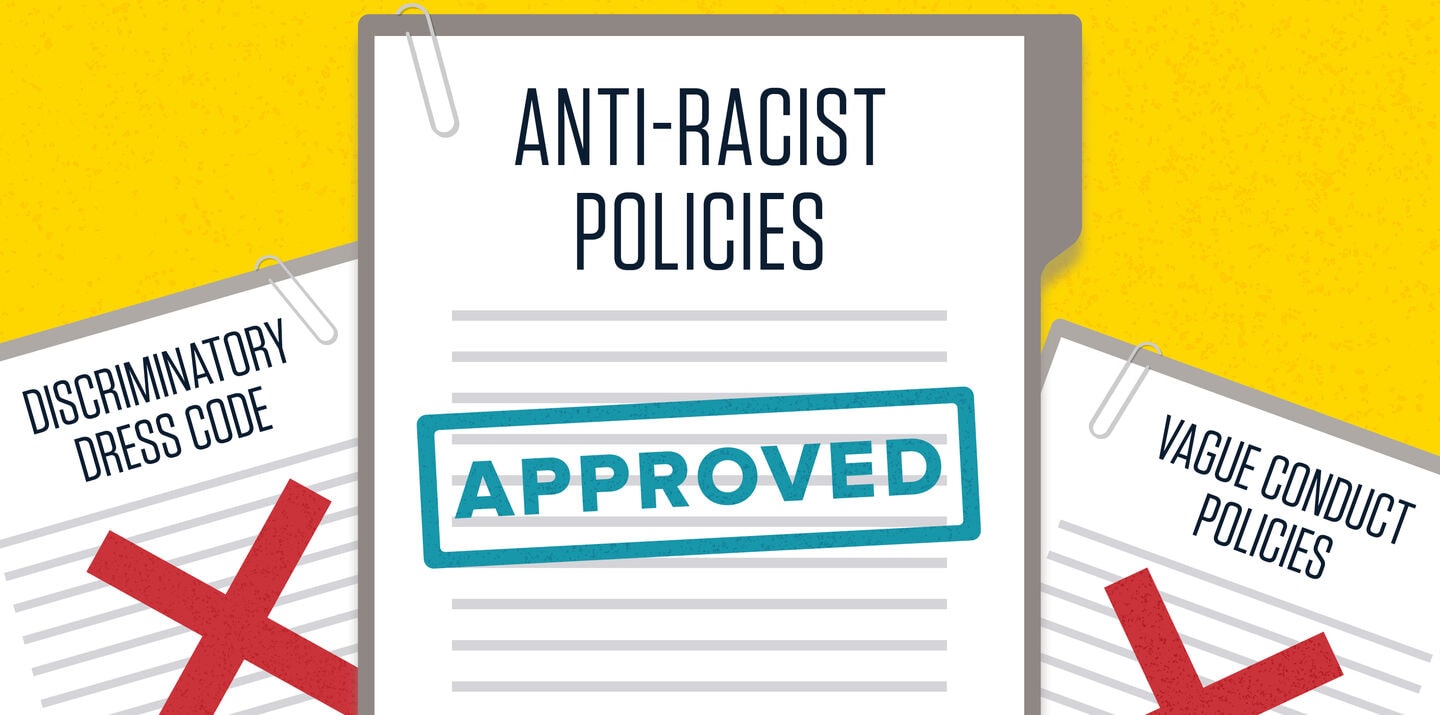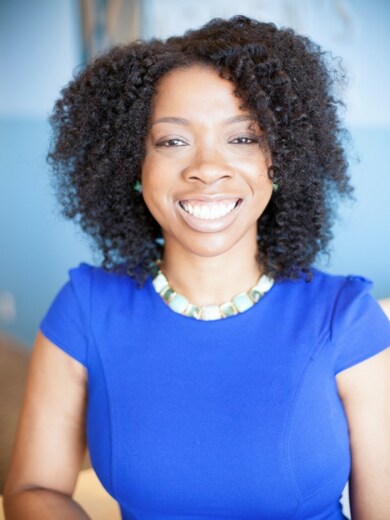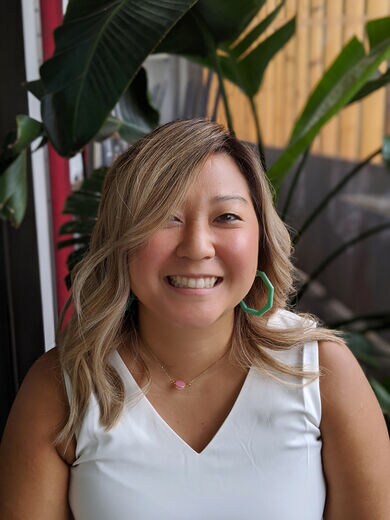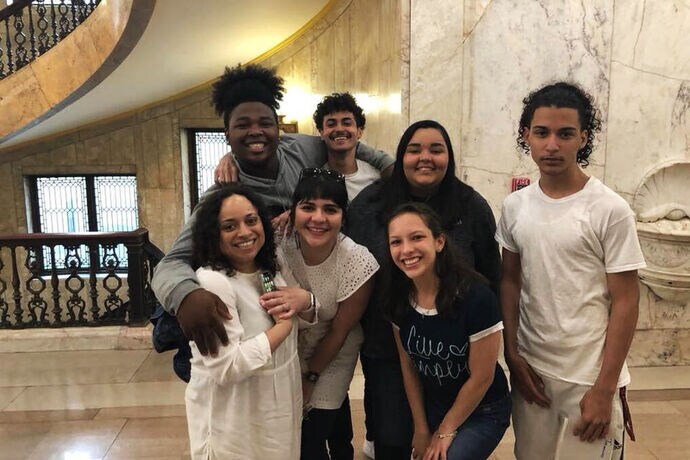
Shaping an Anti-Racist School Culture
School leaders are reassessing policies around hair and dress codes, conduct, and hiring as they commit to the work of building an anti-racist school culture.
At S.T.A.R. Academy-PS 63 in New York City, the school team has spent the past five years working hard to examine its policies and practices through a racial equity lens—from uniform policies to homework, from lesson plan structures to grading systems, from referrals to special education to classroom removals and the school’s “responsibility room.”
The responsibility room was designed as a calming space outside of the classroom for kids to take a break if they were having a difficult time in class. But when Assistant Principal Jodi Friedman (New York ‘04) and the school’s Equity Team reviewed the data, they found that Black and Latinx boys were choosing to leave the classroom at a disproportionate rate that tracked with trends associated with the school-to-prison pipeline.
This year, the school team is being very intentional about what they can do to keep kids in the classroom, starting with deep self-reflection. Staff examined their biases, teaching methods, and classroom culture to uncover practices that were unintentionally hurting relationships with students.
“We really thought about what was harmful in our own teaching practice and curriculum and how these systems weren’t always designed for our students,” Friedman says.

The school team shifted the language around the newly renamed "reflection room." Additionally, every classroom now has a “calm corner,” a designated space where students can take a break and still be part of the classroom community. Through collaborative problem solving teachers help students identify the cause of the problem and work together on solutions.
“If we're really talking about relationships, the repair needs to be done in the space where the harm was done and where the teaching needs to happen,” Friedman says. “Often this means that the staff member may need to do some repair because their words or actions created harm too.”
Get more articles like this delivered to your inbox.
The monthly ‘One Day Today’ newsletter features our top stories, delivered straight to your in-box.
Content is loading...
As the school team reexamined policies around student behavior, they also explored the notion of respect, and how respect can look very different depending on the cultural context. A student who is loud or talkative or who does not make eye contact can also be engaged in learning and is not necessarily misbehaving. Rather than having rigid rules around behavior, the school team developed classroom rights—community agreements around what students and staff need from each other, such as accountability and being a team player.

School policies like the “responsibility room” are set in place intending to establish expectations for student behavior and to create a productive and safe school environment for students, teachers, and school support staff. However, racism can show up in school policies in a variety of ways, and even the best-intentioned school policies can sometimes have negative consequences—especially for communities of color.
Some disciplinary policies can push students of color out of the classroom and minimize their time spent learning and developing as scholars. Other policies regarding dress code and hair style policies can send harmful messages to Black, Indigenous, and students of color that they are unwelcome at school as their authentic selves. Staffing policies can perpetuate the hiring of educators and school leaders who fail to critically analyze their biases or involve families and community members in important decisions.
All of this can result in a school culture where students and staff of color do not feel supported, safe, or empowered.
That’s why many school leaders and educators are looking to go beyond uprooting the white supremacist viewpoints baked into their curriculums. They’re also working with students, families, and their communities in a number of ways to reimagine their school policies. Together, they’re interrogating how those policies either help or harm their efforts to build a truly anti-racist school culture, and making adjustments accordingly.

When Dress, Hair, and Conduct Policies Hurt Students
Dress and hair policies are some of the more immediate examples of policies that can harm students of color and keep them out of the classroom. Policies around hair and dress codes can be harmful when utilizing coded language such as describing some hairstyles as “neat” and other hairstyles worn by Black students, such as natural or braided hair, as “unkempt.”
“Sometimes, dress codes actually have racial and sex bias built into it,” says Adaku Onyeka-Crawford, the director of educational equity and senior counsel at the National Women’s Law Center (NWLC), a nonprofit that advocates for women's rights through litigation and policy initiatives.
“You see dress codes that ban things like hair wraps, or Afrocentric hairstyles, or even baggy jeans, which usually affects Black boys and also gender non-conforming children,” she continues. “It's very racialized, and it's targeted to punish things that are worn by Black children.”
Some conduct policies make use of vague language around “attitude” violations. This can allow for unequal enforcement of the rules and unfairly target students of color, according to Onyeka-Crawford.
“I think the thing that most disproportionately affects Black girls are these really harsh punishments we see for subjective or minor offenses,” Onyeka-Crawford explains. “What it essentially amounts to is suspending students for normal teenage behavior, such as being ‘sassy’ or having an ‘attitude.’ But when it's coming from a Black girl, it's being coded as being defiant or insubordinate.”
“It's based on these race- and gender-based stereotypes,” she continues. “Whereas a white student might get detention or a demerit, you see Black girls being sent to the principal's office, or suspended, or sent to in-school suspension.”
These policies have serious consequences. Black girls are 5.5 times more likely to be suspended from school as white girls, Latina girls are 1.6 times more likely to be suspended than white girls, and American Indian/Alaskan Native girls are three times more likely to be suspended than white girls, according to NWLC. Even as early as preschool, Black girls make up 20 percent of the girls enrolled in preschool, but receive 54 percent of out-of-school suspensions.
In response to these harmful policies, NWLC created the “Let Her Learn” campaign. This campaign raises awareness of the educational barriers that Black, Brown, and Indigenous girls face due to school policy. It also gives students, parents, and educators the tools that they need to dismantle those barriers and ask critical questions of schools and their conduct policies. The campaign also elevates student-led solutions to eliminate racism and sexism in school through a series of reports and resources. Some examples include a report highlighting the problems and solutions associated with dress code enforcement that targets Black girls, the need for mental health supports for Latinx students, and the creation of a culturally-affirming curriculum that teaches advocacy through the experiences for queer and trans people of color.

Replacing Vague Conduct Policies with a Defined Culture of Respect
When students are sent out of the classroom for minor infractions such as using a cellphone or “talking back,” the consequences can be long-lasting. Students who face this type of discipline may view themselves as incompatible with schools, which ultimately damages their self-image as scholars and learners.
All of this feeds into what is known as school pushout, according to the nonprofit Dignity In Schools, and it leads to three million students being suspended from school each year—the majority of whom are students of color.
For schools endeavoring to be anti-racist, having clear language around what a culture of “respect” means in the classroom can help address this issue of vague conduct policies for students and staff alike, says Evalaurene Jean-Charles (New York ‘20), an educator and founder of Black on Black Education. Black on Black Education is a platform intended to bring Black educators, experts, and thinkers together to reimagine education in the Black community through podcasts, events, and conferences.
“There needs to be a definition of respect and of disrespect,” Jean-Charles says. “It needs to be very clear, very concrete, and it needs to be everywhere so that everyone has a common understanding of what respect means.”
“Have a clear, overarching understanding of what subordinate and insubordinate means. Define what disrupting the classroom means in definitive language that students can understand,” she continues. “Otherwise you're going to run into continued suspensions for students being ‘insubordinate.’ It gives teachers way too much autonomy over if a child and when a child gets and receives the education that they need.”
Investing in Mental Health, Not Discipline
When students spend more time outside of the classroom than in it due to suspensions and expulsions, it creates a cycle of students falling behind academically, dropping out, or becoming involved in the juvenile justice system. What can break this cycle is addressing the underlying causes of the student’s misbehavior through compassion and mental health services.
Schools with mental health resources see improved attendance rates, better academic achievement, and higher graduation rates as well as lower rates of suspension, expulsion, and other disciplinary incidents, according to a 2019 report by American Civil Liberties Union on the lack of mental health staff in schools.
Mental health resources in schools include nurses, counselors, social workers, and behavior therapists. These resources can also include a focus on social-emotional learning in the curriculum and practices like restorative justice, which prevent and repair harm and strengthen the school community—like S.T.A.R. Academy’s approach to phasing out the “responsibility room” to opt for incorporating wellness spaces within the classroom. Some educators are reimagining the in-school suspension room itself and the purpose it serves.
“If we're going to have a conversation about in-school suspension, well, maybe it's not a suspension,” Jean-Charles says. “Maybe that student just needs some more individualized attention that day. Maybe they just need a little bit more information that day. Maybe they just need a little bit more care that day.”
“The in-school suspension office room needs to be somewhere where students can go and get their needs met,” she continues. “And when they walk back in the classroom, the next period or the next day, they are still on the path with the rest of their class, but they also feel better. They feel seen and they feel whole.”
Reimagining the ways in which schools can support students through wellness instead of discipline can be crucial for students of color who have experienced trauma outside of school. This is an experience that Jean-Charles knows all too personally.
When Jean-Charles was in middle school, she struggled with a number of traumatic events at home. She lived with her grandmother and various aunts and had to switch schools frequently. One week in eighth grade, Jean-Charles had to testify in court for a sexual violence trial, attend her grandmother’s funeral, and then be at school that Monday. But none of her teachers were aware of this.
“I was expected to be a full human, coming to class, to fully understand, take my test and be completely normal while my life outside of school was not in a place that was conducive to me doing that.” says Jean-Charles. “Because we live in a white-dominant society where a two-parent home and a middle-class family is what we build schools around, we are doing an extraordinary disservice to students of color and students with stories like mine.”

Analyzing Grading Policies
Building an anti-racist school culture also requires educators and school leaders to interrogate how they approach concepts such as grading and seat time. In some schools, a student’s adherence to those classroom policies may be valued over their proficiency and confidence in the content matter.
This can create a strict system of conformity that does not serve the best interest of students of color and their growth as scholars.
After serving for seven years in school leadership roles, Karima Wilson (Houston ‘03) wanted to take what she had learned about implementing more equitable school policies and share it with other school leaders. She launched Forged Ed, an organization she founded to help educators build schools where students of color thrive.
Wilson supports educators around the country in examining instructional policies and practices such as grading. Traditionally, students receive grades based on a teacher's assessment of their knowledge and skills, their in-class participation, effort, and homework. Such policies can mean that a student's grade reflects a teacher's perception of their behavior instead of their ability to hit their learning targets. Mastery-based grading, sometimes called standards-based grading, assesses students on their mastery of the objectives, and allows students multiple opportunities to demonstrate achievement.
“In a school that assumes mastery grading, kids can retake a test and homework counts minimal because we know that not all kids have equal ability and access to doing homework in the same ways at home,” Wilson says.
Prioritizing mastery isn’t lowering the bar; rather it’s giving students an equitable opportunity to master content before moving on to something new.

Jacqueline Adam-Taylor (Greater Philadelphia ‘07), a principal at the High School of Commerce, working with Executive Principal, Paul Neal in Springfield, Massachusetts, made an important discovery about seat time during her school’s shift to virtual education due to COVID-19.
Many students who came to school infrequently prior to the pandemic were logged online every day and doing great work online. On the other hand, many students who came to school regularly prior to the pandemic struggled with the transition to online work.
It raised many questions for the school staff about how to respond flexibly to the needs of students and families while still maintaining high expectations for mastery.
“We started to really understand that some of our policies—like our stance on no virtual or that you can't make up assignments at your own pace—really disadvantaged some of our students,” Adam-Taylor says. “We're revisiting what that looks like and feels like, because for many of our students, trauma is real, mental health issues are real.
Interested in Joining Teach For America?
Bringing Parents to the Table and Sharing Power with Communities
Schools can also be intentionally or unintentionally racist when they make decisions without involving or partnering with communities. Sharing power with families is essential when reckoning with the legacy of a school system that has historically made decisions for—not with—communities of color.
“If we don't connect with our families, then are we really helping our communities? Or are we still making decisions for Black and brown students and families without their say so,” Adam-Taylor says. “Without the conversation with our community and families, we're essentially being racist and saying that we are better than the Black and brown communities that we serve.”
School leaders who endeavor to build anti-racist schools are finding ways to bring families and community members into critical conversations about how their students are being taught and supported in school.
For the High School of Commerce, the coronavirus pandemic prompted school leadership to add a primary person model to their school. Staff members were each assigned a small group of students with whom they had a relationship with before the pandemic. Each week, that “primary person” would be responsible for checking in with those students and their families.
“This helped us know how students were doing as a whole person and to see if the family was in need,” Adam-Taylor says. “We were able to refer students to therapeutic services if needed, work with families to get social services, and to promote our free meal program.”
At S.T.A.R. Academy, the school team has implemented a variety of opportunities to center the voices of parents and give them more autonomy over how decisions are made. The team launched a working group for parents to review lessons through a culturally responsive lens. They also hold listening conferences at the beginning of the school year where parents can share about their cultural celebrations, and motivations and strategies for working with their kids.
“I think part of that anti-racist lens is shifting that power,” Friedman says. “We started thinking about our interactions with parents. And most of the time they come in for conferences and we tell them about their child. If we really do believe parents are experts on their children, how are we setting the tone for that?” Other times, school policies can be non-inclusive of families who face barriers to parental participation. Low-income parents and guardians are more likely to hold multiple inflexible jobs or work evenings, making it difficult for them to attend school meetings or functions. This can send a message to these families that they’re not wanted at the school, or that the school wrongly views their lack of involvement as a lack of caring about their child.
Janelle Silva is an associate professor of psychology at the University of Washington Bothell and studies equity in K-12 schools. She recalls working with a school where parents were required to complete 60 hours of volunteer work during the school year.
For parents who may have multiple children and multiple jobs, time is scarce and that sort of commitment can be impossible.
“That's just another form of structural racism,” Silva says. “You're not allowing them the advantages to be in this school and to make these connections and to be in a place that really honors culture, because you're not willing to make an exemption for families who don't have the ability.”
The Importance of Assessing Anti-Bias While Hiring
Most teachers go into the profession because they deeply care about students. That’s why it can be difficult for many teachers to accept that despite all of their care for their students, they can still do harm to them through biased and white supremacist practices.
The fact is that every person possesses biases—even educators. A 2020 study by the American Educational Research Association titled “Teachers Are People Too” found that teachers are just as likely as non-teachers to have racial biases.
For many school leaders committed to building anti-racist schools, probing job applicants’ understanding of unconscious biases is becoming an essential part of the hiring process. But what’s most important to these school leaders is that potential hirees possess critical awareness of their biases and a consistent commitment to interrogating the ways they may do harm to others.
For Adam-Taylor, asking about bias and white supremacy culture has become part of the screening process during job interviews.
The skills and values that Adam-Taylor and her fellow school leaders look for are an unwavering belief in students and the knowledge that love isn't enough—that you can love students and still do harm to them.
“We are working in a white supremacy system, and so we all have bias because of all the mixed messages we've been given our entire lives,” Adam-Taylor explains. “Even if we're people of color. For me, as an Asian American woman, I have to dismantle a lot of the biases that have been ingrained, pause, think about it, name it out, and make a course correction.”
As a result, the question probing anti-bias during the High School of Commerce’s interview process had a clear exemplar, and potential candidates would not be able to move forward if they failed to meet that exemplar.
At Purpose Prep Academy in Nashville, which serves a majority Black population of K-4 students, consciousness of biases is a non-negotiable for hiring. Lagra Newman (Los Angeles ‘05) is the founder and head of school, and as the school has grown, she’s continually refining questions in the interview process that gauge a candidate’s level of awareness about the systems that hold back Black and brown children in school.
“It has always been important that individuals who are joining our work understood the system and how the system—a very racist system—perpetuates that type of failure,” Newman says. “It is really critical that individuals understand the nuances of our system and how it contributes to low expectations for children, which is part of the failure.”
At S.T.A.R. Academy, teacher candidates engage during the interview process in a scenario discussing community helpers—police, firefighters, the mail carrier—in a kindergarten classroom. The team looks for candidates with the skills and openness to have difficult conversations about race in the classroom. Friedman shares an example:
“One of the questions is, how would you respond if a kid who raised their hand and said, ‘The police are not helpers, they kill people.’ Would you shut it down? Would you engage? Would you say, ‘That's interesting, let's talk about it later,’ knowing that you don't have the answers in that moment, but it's important to talk about?”
Examining the Why Behind Every Policy and Practice
Even the best-intended policies can fail to be anti-racist or even perpetuate white supremacy culture if educators and school leaders do not critically analyze the “why” behind every policy and practice when implementing them.
Adam-Taylor and her team learned the importance of explaining the why behind policy changes when they phased out their dress code this past year. Adam-Taylor and the school leaders of the High School of Commerce were concerned that uniforms were limiting their students’ self-expression—and that the uniforms could even be perceived to mirror prison uniforms.
However, the leadership of the High School of Commerce did not explain the intention of the policy to the student body or to families. “We got rid of it without a why,” Adam-Taylor explains. “Our students perceived it as us having lowered expectations. It was a missed opportunity because we moved really, really quickly with it.”
For the next year, Adam-Taylor and her team plan to review the feedback from parents and students about the dress code and calibrate a new dress code that takes into account the expectations of the community.
After a parent at Purpose Prep Academy shared similar concerns about the school’s required uniforms limiting children's freedom of expression, the school team invited parents to participate in a conversation. There, the Purpose Prep team clarified the intent of requiring uniforms, which is to make dressing for school more equitable among families. The school team then worked with parents to brainstorm ways for students to express their culture and identity at school while honoring the school’s commitment to equity.
The school has since implemented a monthly “Identity Day,” where instead of wearing their uniform, students could choose to dress as someone who represents a facet of their identity. The program allows students to creatively express themselves in a way that also affirms their identity.
“We constantly center around the purpose behind what we do,” Newman says. “And so that's important to be conveyed too so that we understand the why. I think that there are so many structures for how to run a school, but if you lack the purpose, the way that it's implemented is not intentional. And it’s the difference between purpose versus power.”

Building a Culture That Supports Staff in the Long-Term Effort of Anti-Racism
Working to create anti-racist policies in school is an ongoing, long term effort. There isn’t a perfect place to start. The most important thing is to start somewhere, say those who are involved in the process at their schools.
The 2016 election was a pivotal moment for stirring conversations about racism and identity and the impact of the national climate on students. At S.T.A.R. Academy, after two teachers shared feedback questioning why staff members weren’t having more conversations about race in light of these national conversations, the school took a critical look at their structures and systems. They found that teachers and school leaders alike were unsure where to begin with these difficult conversations.
As a starting place, Friedman and her principal, Darlene Cameron, brought in the Center for Racial Justice to give staff a historical overview of racism in the United States and get everyone on the same page.
“Once we just got some language—even the definition of racism involving the idea of power—that was new for a lot of folks,” Friedman says. “Just understanding these things was an important step.”
Even schools with a heavy focus on discussing race and identity aspire to do more. At Purpose Prep, the school team hired a diversity coordinator to bring more intentionality and structure around how the team talked about race and biases.
A positive outcome is that staff now gather on a trimester basis for ongoing professional development. But Newman is looking to continue to improve the way students are supported, both in response to national racist incidents, and as part of the school’s commitment to creating an affirming environment for all students.
“We realized at the heels of some of these events that even that isn't enough. What's the type of understanding that we need to make sure staff have, and how are we continuing to educate ourselves,” Newman says. “How do we even more deeply understand the systematic structures that continue to perpetuate, the events that are taking place, and what that means for our activism and the stance that we're taking?”
Creating a school culture that supports staff no matter where they are along their journey has helped many school leaders progress in the often messy and uncomfortable but essential work of anti-racism. It’s what helped S.T.A.R. Academy get their work off the ground five years ago.
This can look like staff pulling each other aside for quick feedback and more openness to asking difficult questions. The school team has worked hard to create a space where kids can truly be heard, and where staff are empowered to call each other in, and embrace discomfort. This work has been years in the making.
“Five years ago we weren't comfortable being in that space,” Friedman says. “We weren't able to take any risks because we were so petrified of what would happen if we did it wrong or failed. So we wouldn't broach it at all.”
“If we really want to be anti-racist, it is an active effort,” she adds.
What’s Possible for Students Through Anti-Racist Policies
Every school is in a different place along their journey to dismantling racism. This work is deeply challenging, ongoing, and it can be hard to know where to begin. Mistakes will inevitably happen along the way. But for school leaders dedicated to building a school culture of anti-racism, seeing their students—and staff—thrive under new policies gives them the motivation to continue the work, no matter the obstacles.
At the High School of Commerce, Adam-Taylor has seen promising improvements in students’ attendance and grades after implementing two new policies. The first was an academy program for students struggling with their academic progress during ninth grade. The program offered students access to smaller classes and an advisor.
“We were able to increase in-class attendance for students in the program by 30 percent and we had two students from the program out of 75 make the Honor Roll,” Adam-Taylor says. “A student who was previously suspended on an almost-weekly basis built trust with our team. They began going to class on a daily basis, advocated for an independent music study class, and started planning a concert for staff.”
Adam-Taylor also enacted a new school hiring practice bringing students into the second phase of the teacher interview process, empowering students to take an active role in shaping their school community. Students give tours to candidates, ask questions of the candidates, and participate in evaluating and offering feedback to their demo lessons.
“This practice allowed both candidates and our school community to build relationships before even accepting the job,” Adam-Taylor says. “We saw an increase of student attendance overall, and I received many requests from students asking to do more panels.”

Measuring the outcome of anti-racist school policies is often highly nuanced. But these nuances matter. At S.T.A.R. Academy in New York City, Friedman is encouraged by seeing improvement in students’ academic scores, and student responses on satisfaction surveys. She suspects her school’s efforts to create a more safe and inclusive learning environment are likely contributing to this improvement. She’s also seeing shifts in student and staff behavior that show promise.
As the school’s culture has shifted, staff and students are more conscious of and willing to discuss racial inequities—both in the classroom and outside of school. And they are building the vocabulary and confidence to talk about these issues when they come up. Friedman says staff are more willing to “call each other in” and support each other through learning when microaggressions occur—something that wouldn’t have happened five years ago.
For Friedman, one of her measures of success is simply an increased willingness within herself and among students and staff to initiate critical conversations about race and see them as learning opportunities.
“Seeing more of our staff members and school leaders feel more comfortable creating these spaces, knowing that we might not have the answer, shows me that we are creating a better school,” Friedman says.
Read more about how schools across the country are reexamining their curricula to ensure their content and delivery are centered on equity.
We want your feedback. Share your thoughts on this story or suggest other stories for us to pursue.
Sign up to receive articles like this in your inbox!
Thanks for signing up!
Content is loading...










